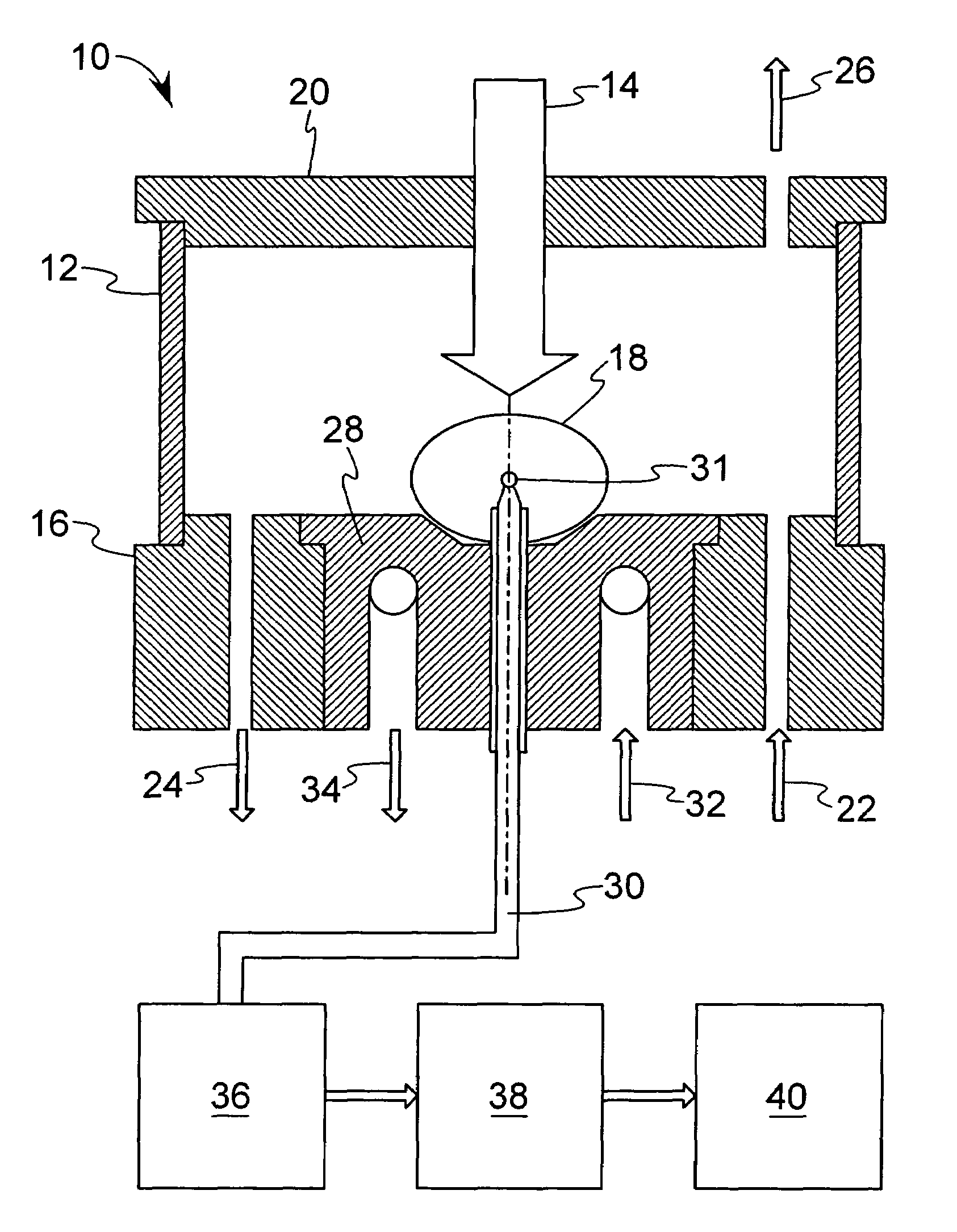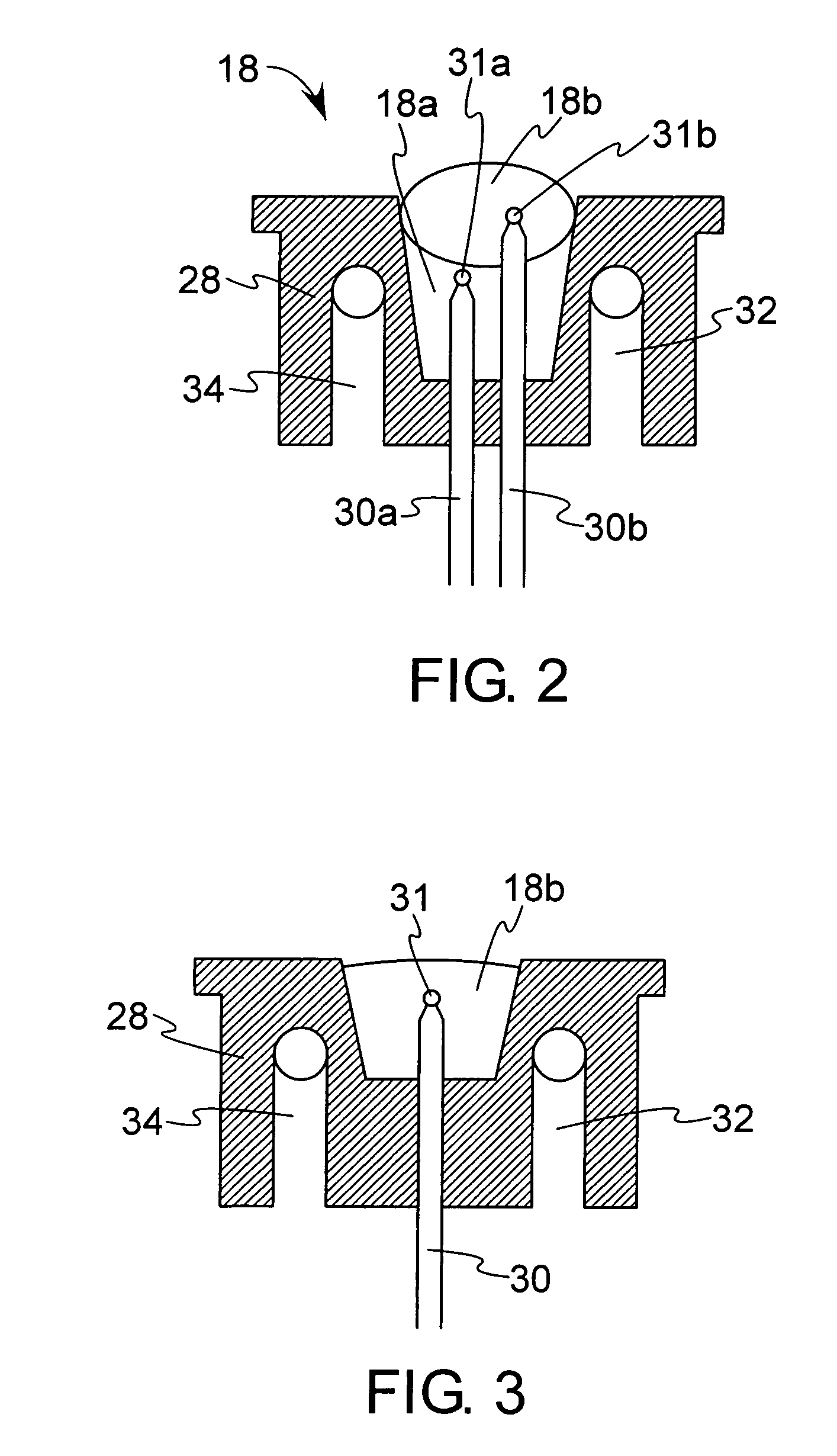[0017]The capability of the SSDTA method is valuable for numerous actual and simulated
metal processing applications. In
welding-specific examples, it can be used for investigating the solidification range and solid-state phase transformations under actual
welding conditions, constructing CCT diagrams for as-solidified and heat-affected weld
metal. For example, valuable information is provided about the weld
metal microstructure evolution in the typical range of cooling rates for
shielded metal arc welding (SMAW). The range of welding conditions which provide an
optimal combination of microconstituents with respect to
weldability and mechanical properties is determined. The SSDTA method provides reliable, fast and inexpensive monitoring of phase transformations under actual welding conditions. This can be beneficial for the development of welding
consumables and welding procedures. Of course, the benefits are not limited to welding, and it will be appreciated by those skilled in the art that other material processing applications can be used. For example, the SSDTA can also be used for determining
forging and heat treatment temperatures ranges, the onset of recrystallization, and ferromagnetic / paramagnetic transformations (the
Curie temperature), among other things.
[0018]The present invention can be useful in correlating the solidification ranges of material specimens and their solidification
cracking temperature ranges (SCTRs). The SSDTA method has great potential for determining weld solidification
cracking susceptibility based on the actual solidification temperature range. It allows the detection of eutectic
phase formation and the determination of such material-specific parameters as the size of the solidification range and the non-equilibrium
liquidus and
solidus temperatures that are directly related to solidification
cracking susceptibility. Compared to conventional DTA, the SSDTA has equal or similar accuracy, and is further applicable in actual processing, as well as in simulation of non-equilibrium processing conditions.
[0019]Compared to the methods for revealing the thermal effects of phase transformations over the recorded thermal history (
thermal analysis) and the methods for analog and digital differentiation, the proposed SSDTA method allows more precise determination of the phase transformation start and finish temperatures. In addition, compared to the in-situ application of the two
thermocouple DTA method, the new technique does not use a reference
thermocouple or related sensor, thus simplifying the measurement and allowing its application in weld metal and avoiding additional experiments for determining the optimal distance between the thermocouples in order to optimize the sensitivity. Moreover, it permits controlling the sensitivity to the thermal effects of phase transformations and processing separate parts of the measured thermal histories, thus increasing the accuracy. Thus, it can be seen that the SSDTA method has tremendous application potential for the reliable determination of the solid-liquid and solid-state phase transformation temperatures and structure changes under the conditions of actual or simulated welding,
casting, heat treatment and other thermal and thermo-
mechanical processes.
[0020]The SSDTA method is verified by comparison to dilatometric analysis using a commercially-available thermal simulator. The SSDTA method is also verified by comparison to conventional DTA using commercially-available DTA equipment. The accuracy of the SSDTA method is confirmed by determining the solidification temperature and the
Curie temperature in
pure metals. The results of these tests proved that SSDTA has higher sensitivity to phase transformations than dilatometric analysis. It was also shown that SSDTA has equal sensitivity and accuracy with the conventional DTA in determining phase transformations and structural changes. The SSTDA is applicable in actual and simulated processing conditions, thus providing a superior alternative to the available in-situ and simulation techniques that generally use different variations of DTA or dilatometric analysis for determining the phase transformation temperatures.
[0023]According to another aspect of the invention, a device for investigating phase transformations in a material is disclosed. The device includes a chamber defining a substantially enclosed environment, a source of energy configured to heat a specimen of the material that is placed in the chamber, and a mold defining a place where the specimen can be either placed while being heated, or where the specimen can be collected in once it has been partially or completely melted. In the present context, the term “substantially” refers to an arrangement of elements or features that, while in theory would be expected to exhibit exact correspondence or behavior, may, in practice embody something slightly less than exact. As such, the term denotes the degree by which a quantitative value, measurement or other related representation may vary from a stated reference without resulting in a change in the basic function of the
subject matter at issue. In addition, the device includes a
hearth that is either disposed in the chamber or forms a part (such as a lower surface) thereof. The
hearth is configured to be cooperative with the mold such that upon heating of the specimen in the chamber, at least a molten portion of the specimen collects in the mold. In addition, the device includes a
data acquisition system that includes a temperature measuring sensor and a computation device. The temperature measuring sensor is placed adjacent the specimen such that it is in thermal communication therewith to sense the temperature of the specimen, while the computation device (for example, a computer) converts the measured temperature data into phase transformation information. Conversion of the measured temperature data is facilitated by comparing it to reference thermal data such that differential data that corresponds to specimen phase transformation is produced.
 Login to View More
Login to View More  Login to View More
Login to View More 


